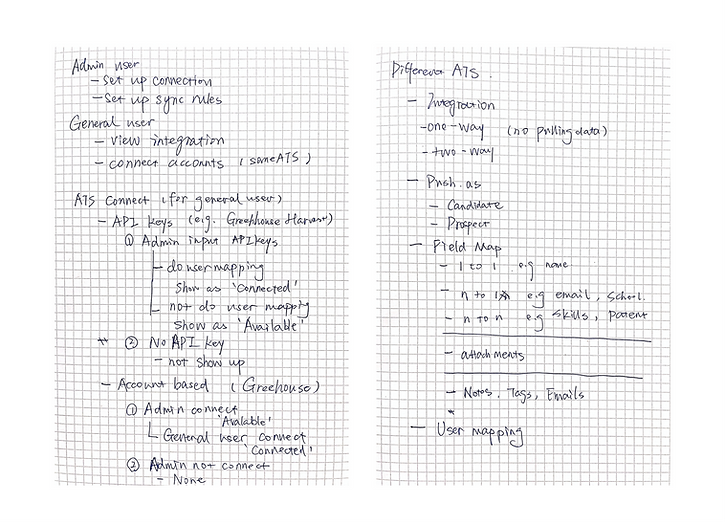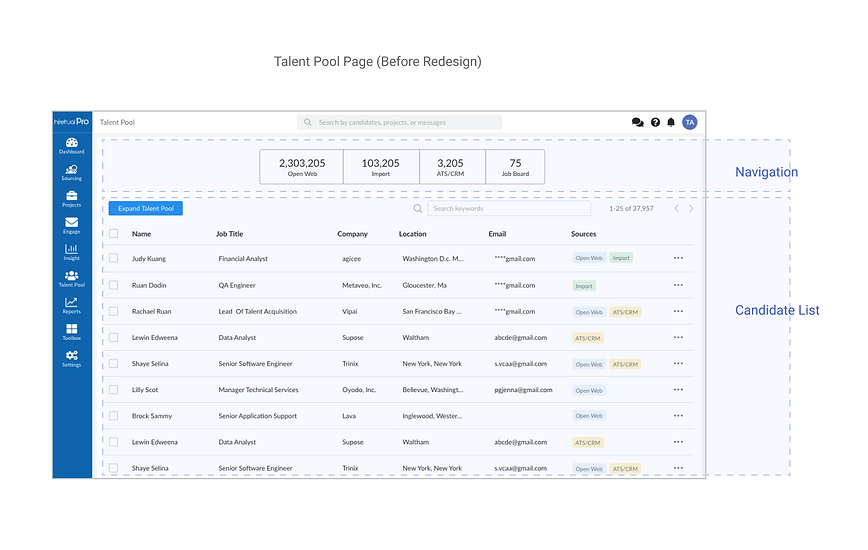
Build a rich and clean talent data cloud
Deduplicate and enrich profiles in the talent pool with Applicant Tracking System (ATS) integration
TEAM
Designer
Engineer
Data Analyst
MY WORK
UX Design
UI Design
Prototype
You can watch an feature introduction video here.
A demo video of Greenhouse integration is here.
# WHY DESIGN FOR ATS INTEGRATION?
ATS is a rich source of talent
Each customer has their own talent pool which includes candidates they sourced from Hiretual talent data cloud or from their ATS/CRM and candidates they found on public website. Among all these sources, ATS/CRM is an important way to get candidate, especially for an active job position.

And talent rediscovery becomes a trend ...
Companies spend time and money collect thousands of resumes for previous positions, but a majority of them are not looked at twice. Meanwhile, they feel there are insufficient candidates. This is why talent rediscovery becomes a trend. Hiretual also aimed at expanding its business to this area. To encourage talent discovery, the first step is established the connection with commonly used ATS softwares and being able to sync and clean data collected from them.

#WHAT'S THE PROBLEM WITH CURRENT SOLUTION?
Current ATS integration is not customziable and usable
Before this project, the integration is done manually by our developers in the backend when our customers initiated a request online. Once completed, a script will run once a day to pull the data from ATS to Hiretual or push the data from Hiretual to ATS.
There are two types of problems with this solution.
When integrate with ATS
Repetitive work
Every request from customers requires developers to write a new script.
Not standardized
Customers may ask for further customization based on their needs and the ATS they use.
When sync with ATS
Not transparent
If the sync fails, users do not know why it fails and how to fix it.
Duplicate profile
If duplicate profiles cannot be merged based on sync rules, customers are not able to handle them manually.

The goal is to automate the ATS integration
To solve the problems above, we decided to streamline the integration process so that customers can easily configure the integration themselves. Meanwhile, they can track all the syncing tasks and take actions accordingly.
# SOLUTION
Automated ATS Integration
I worked closely with backend engineers during this project because technical feasibility is a main challenge. I started from understanding different ways to establish a connection with ATS, restrictions on access, what data fields are required, and possible causes of syncing error. Then I extracted a generic flow for syncing.
Define a generic user flow (For admin)

The challenge here is the generic flow is an ideal flow. In reality, because every ATS has different APIs and access limit for different types of account (e.g. admin user and general user), I have to consider many different use cases. UI also differs slightly in each use case.

Final Design
# SOLUTION
Redesign Talent Pool
Once the connection between ATS and Hiretual is established and configured, the next step is find a place to display syncing errors or duplicates. We went over the current information architecture and decided that talent pool is the most suitable place as it serves as a central hub for managing candidate profiles.

The original talent pool shows only all candidates and their sources. Customers do not know when the candidate is added and whether they are synced or updated.
%202.png)
After redesign, the navigation is optimized and new filters are added so that candidates can be organized by the time and the status of syncing. This will further enable users to easily take actions, such as merge duplicate profiles or re-sync profile.
Final Design
View a demo video
# What I learn
Reflect
This project is unique because it is closely dependent on the technical feasibility. During the design process, I need to not only brainstorm for good user experience in a design mindset, but also actively communicate with developers to understand how things work in the back end, identify different use cases exist and tweak the design accordingly.
Communication is the key. Listen to what developers say, speak the same language and validate the solution using flow charts or draft sketches facilitate the communication.










